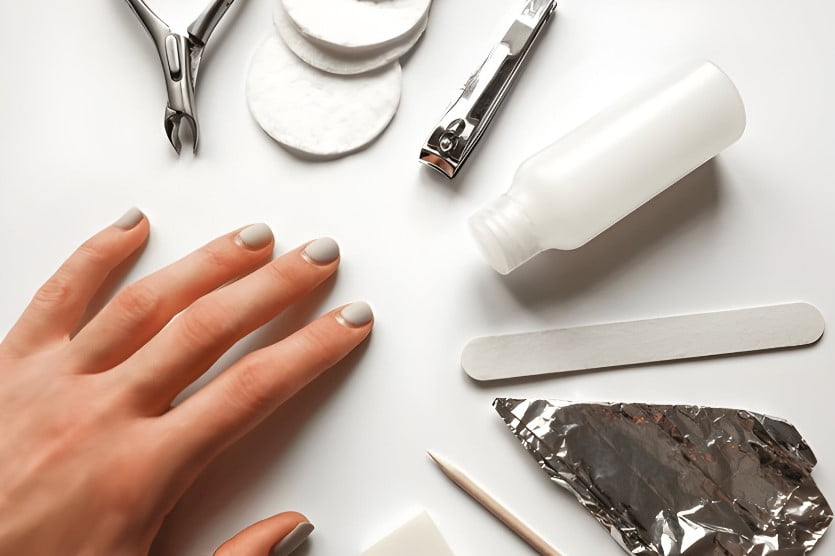DIY Acrylic Nail Removal from Home
Removing acrylic nails at home can be challenging, but with the right guidance and products, it can be done efficiently and safely. Whether you’re taking a break to let your natural nails breathe, or simply want a fresh canvas for new design ideas, this guide will cover everything you need to know about DIY acrylic nail removal. Following the right steps is essential to avoid damage and ensure the health of your nails, all while saving time and money.
Key Takeaways:
- Removing acrylic nails at home requires patience, the right tools, and safe techniques.
- Preparation is key; gather an acrylic nails kit that includes necessary tools like acetone, cotton balls, and a nail file.
- Taking proper care of your nails post-removal helps maintain their natural beauty and resilience.
- Never force or pry off acrylic nails to avoid trauma to the nail bed.
- Always follow up with acrylic nails health and maintenance practices to keep nails strong and healthy.
1. Why Remove Acrylic Nails at Home?
For many, heading to a salon for acrylic nail removal is a go-to solution, but removing acrylics at home offers convenience and cost savings. Additionally, with the rise of self-care routines and DIY beauty, many are opting to learn how to remove acrylics themselves. Whether you’re between salon visits or simply want a break from acrylics, mastering the art of DIY acrylics nails removal is valuable knowledge.
2. Supplies You Need for Acrylic Nail Removal
To ensure a smooth removal process, gather the following items typically found in a standard acrylic nails kit:
- Pure acetone
- Cotton balls or pads
- Aluminum foil
- Nail file and buffer
- Cuticle pusher or orange stick
- Bowl of warm water
- Cuticle oil and hand cream
With these tools, you’ll be able to tackle the removal process safely and efficiently.
3. Step-by-Step Guide to Removing Acrylic Nails at Home

Step 1: Trim Your Acrylics
Start by trimming down the acrylic nails. Use a nail clipper to cut them as close to your natural nail as possible, making the removal process easier and faster.
Step 2: File the Top Layer
File down the shiny topcoat using a coarse nail file. This helps the acetone penetrate more effectively. Avoid over-filing, as you don’t want to reach your natural nail.
Step 3: Soak in Warm Water and Acetone
Fill a bowl with warm water and place a smaller bowl with acetone inside. Submerging your hands in acetone directly can be drying, so wrapping acetone-soaked cotton balls around each nail and securing with foil is a gentler alternative.
Step 4: Wait and Gently Remove
Let your nails soak for 20-30 minutes. The acrylic should start to soften. Use a cuticle pusher or orange stick to gently push the softened acrylic off your nails. Repeat as needed until all acrylic is removed.
Step 5: Buff and Shape
After the acrylic is removed, use a buffer to smooth out the nail surface and shape your nails. This prevents snags and promotes even growth.
4. Aftercare for Your Natural Nails
Proper acrylic nails health and maintenance after removal is essential. Start by moisturizing your hands and nails with cuticle oil and hand cream. Your nails will likely feel weaker after acrylics, so give them time to recover.
5. Tips to Protect Your Nails Post-Removal
- Avoid Water Exposure: Excess water can weaken nails further.
- Use Strengthening Products: Nail hardeners and oils can enhance durability.
- Trim Regularly: Shorter nails are less prone to breakage.
- Avoid New Acrylics Immediately: Give your nails a few weeks to breathe and regain strength.
- Be Gentle with Your Nails: Avoid using them as tools for opening or scratching.
6. Common Mistakes to Avoid
Removing acrylic nails improperly can lead to damage. Here are some common pitfalls to avoid:
- Prying Off Acrylics: Forcing them off can tear layers of the natural nail.
- Skipping Moisturizer: Nails need hydration post-removal to recover.
- Not Filing Enough Initially: Failing to remove the top coat can make the process longer.
7. DIY Removal vs. Professional Removal: Which is Better?
Removing acrylics at home is convenient, but salons have specialized tools that can make the process faster. If you are unsure or nervous about the process, a professional removal might be preferable, especially if you’re looking to avoid any nail trauma.
| Factor | DIY Removal | Professional Removal |
|---|---|---|
| Cost | Minimal (usually under $10) | Varies, often between $10 – $20 |
| Convenience | Anytime, at home | Appointment required |
| Effectiveness | Effective with proper tools | Fast and effective with minimal risk |
| Skill Required | Moderate | Minimal (done by professional) |
| Risk of Damage | Higher if done improperly | Lower due to professional care |
8. Maintaining Nail Health Long-Term
After removing acrylics, adopting a healthy nail routine will keep them looking and feeling great. Here are some suggestions:
- Biotin Supplements: Biotin can strengthen nails over time.
- Cuticle Care: Always hydrate cuticles to prevent peeling.
- Regular Filing: Smooth edges reduce the risk of snagging and tearing.
9. Inspiring Design Ideas for Natural Nails
Once you’ve removed your acrylics, a fresh, clean canvas opens up a range of options. Here are some design ideas for natural nails:
- Minimalist Dots: Tiny, minimalist dots at the base or tips look chic and modern.
- Negative Space Manicures: Painted sections with natural areas left exposed.
- Pastel Tips: Pastel French tips offer a gentle, soft look.
- Botanical Prints: Painted florals and greenery add an artistic touch.
- Nail Stamping: Using nail stamps for intricate designs is a quick, easy way to add detail.
10. Benefits of Taking Breaks Between Acrylic Sets
Continuous wear of acrylic nails can weaken natural nails over time, so breaks allow for recovery. Nails can become dehydrated and prone to peeling, making it essential to give them a breather. By taking breaks, you’ll enhance the longevity and resilience of your natural nails.
FAQs
1. How long does DIY acrylic nail removal take?
DIY removal typically takes around 30-40 minutes, depending on the thickness of the acrylic and the products used.
2. Can I use regular nail polish remover instead of acetone?
Regular nail polish remover is not as effective as pure acetone. It may take much longer and may not fully dissolve the acrylic.
3. Is it painful to remove acrylic nails at home?
With the proper technique, removing acrylic nails should not be painful. Avoid forcing or prying them off, which can cause discomfort and damage.
4. How can I restore my nails after removing acrylics?
Using nail hardeners, cuticle oil, and hand cream will help restore moisture and strength. Avoiding additional acrylics for a few weeks is also recommended.
**5. Can I reuse my **acrylic nails kit?
Yes, tools like files, buffers, and clippers are reusable if sanitized. However, items like cotton balls and foil should be replaced with each use.
Removing acrylic nails from home can be a practical, cost-effective way to maintain acrylic nails health and maintenance while giving your nails a break. With the right tools, methods, and care, you can remove acrylics safely, ensuring your nails stay healthy and ready for any design ideas you envision.

